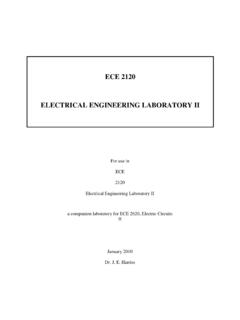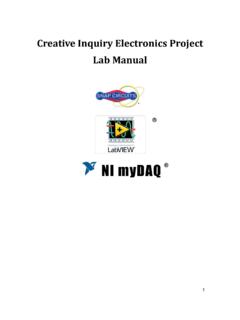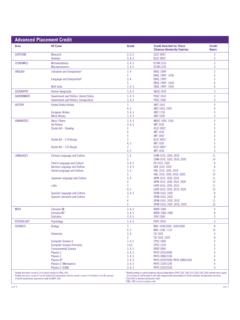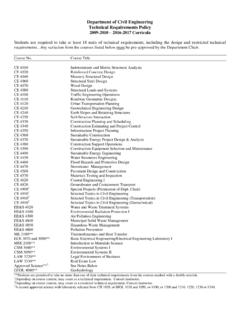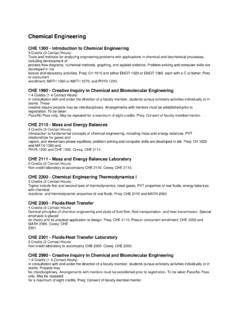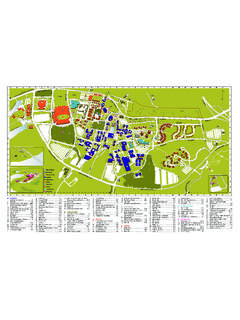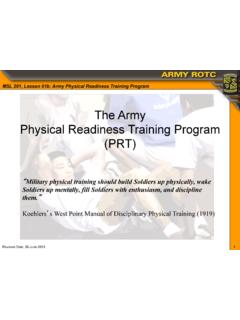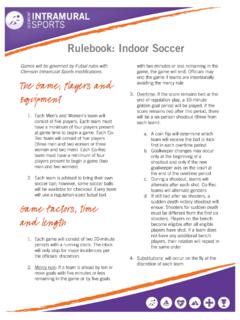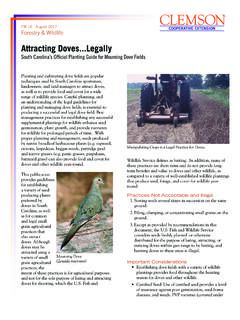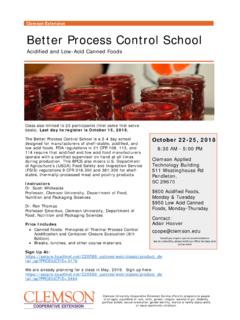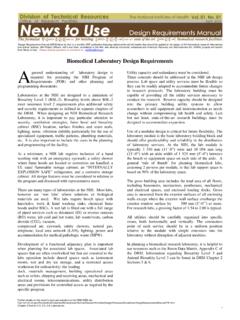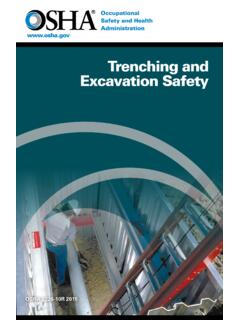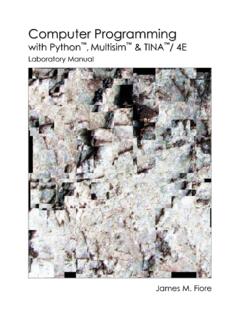Transcription of ECE 311 LABORATORY MANUAL - Clemson University
1 ECE 311 LABORATORY MANUALVER J DuminDepartment of Electrical and Computer EngineeringClemson UniversityClemson, SC, 29634 May 1999 Version , July 2011 J E HarrissECE 311 Electronics IiiJuly 2011 CONTENTSCONTENTS .. iiNotes about the Course .. iiiSyllabus Schedule Example .. viiiSAFETY ..ixStandard Component Values ..xGraph Paper .. xiiLABORATORY Reports ..xvFormal Lab LABORATORY #1 Diode #2 Power Supply Operation ..17 Experiment #3 Power Supply Design ..27 Experiment #4 Diode Clippers and Clampers ..32 Experiment #5 Bipolar Junction Transistor Characteristics ..43 Experiment #6 BJT Common-Emitter Circuit Bias ..53 Experiment #7 BJT Common-Emitter Circuit Voltage Gain ..60 Experiment #8 BJT Common-Emitter Design I ..68 Experiment #9 BJT Common-Emitter Amplifier Design II ..74 Experiment #10 Field Effect #11 FET Bias and Amplification ..87 Experiment #12 Basic Logic Circuits.
2 94 Appendix A: Summary on Report Writing ..100 Appendix B: Tektronix Type 576 Curve Tracer C: Tektronix Type 576 Curve Tracer Operating for acquiring diode forward I-V for acquiring diode forward and reverse I-V characteristics at the same for acquiring ICvs. VCEcharacteristics for a for acquiring IDvs. VDScharacteristics for a D: Hameg HM6042 Curve Tracer 311 Electronics IiiiJuly 2011 Notes about the CourseElectronics I consists of a theoretical module ECE 320 and a practical module ECE courses run concurrently and the aim of the MANUAL is to introduce students to laboratoryprocedure including data recording and report writing. The experiments were developed toexpand on the material covered in lectures and to experimentally demonstrate the validity ofprinciples presented in ECE 320 classes. The MANUAL outlines 12 experiments and instructors willselect the most important topics for experimental : Learning occurs differently for different students and no one approach is 100% work is an effective teaching tool and it is important to realize that it standsalone.
3 There is no plan or need to have a lecture on a subject prior to a lab experienceand a lecture should reinforce learning, but the order in which the learning takes place should notsignificantly affect the is this instructor s opinion that the students would better understand the fundamentals ofelectronics and the use of active devices in electronic circuits if the students were able to buildcircuits and see for themselves that the principles presented in the text are real, or pretty close toreality. It was also felt that the students would become aware of the limitations of the analyticalapproach to active circuit analysis by testing circuits and comparing their results with analyticalsolutions and circuit simulations. Most analytical approaches to circuit analysis use linearanalysis techniques and these techniques are not always valid for non-linear electronics devices,or are valid only over a limited range of currents and component parameters presented in text books are usually nominal values, valid for mostcircuits.
4 By measuring actual device parameters and comparing these values with values in thetext, the students should be able to obtain a feel for the magnitudes of the device parameters usedin the circuits. Experiments in the ECE 311 labs use discrete devices and some parameters (forexample, diode forward current) are often much larger than the values you would measure forsimilar devices on an integrated circuit. The reason is that integrated circuits contain deviceswhich are physically much smaller and hence they are unable to handle as much power as thelarger discrete of the experiments require simulation of the circuits. The simulations discussed in theexperiments assume the students are familiar with B2 Spice (Beige Bag simulation program withintegrated circuit emphasis).It is important that students simulate their circuits beforecoming to the simulations will be extremely important in the design of experiments:it will be impossible to complete the lab without having done the simulations and calculationsbased on these simulations before the lab.
5 Most of the experiments ask that you compare theresults of the simulations and the results of the analytical analysis with the measured results, tosee how the three techniques compare. It is important to gain an understanding of the strengthsand limitations of linear circuit analysis techniques taught in is extremely important for students to read the labs prior to coming to the many cases you will be asked to bring calculated component values and/or simulation resultsprior to starting the lab in order to guide you in selecting component values for your practicalcircuit. You will need this information in order to perform and complete the labs. You shouldalso try to become familiar with standard component values, since your calculations will oftenECE 311 Electronics IivJuly 2011call for resistor or capacitor values which are non-standard and you will have to choose fromstandard components to build your experiments listed in the contents may not be assigned in the order presented.
6 Inparticular the design experiments may be presented later in the course to let classes get ahead ofthe labs. The use of these labs later in the course will allow students to become more familiarwith electronic circuits and devices before attempting circuit design. The design experiments arealso designed as single-student exercises, to test students individual LABORATORY skilldevelopment. The design experiments should be assigned as one-hour lab sessions and may beused in place of a final exam for this the first year of introduction of this lab, the students were asked to complete anexperimental evaluation sheet following each experiment. The students were invited to commenton ways to improve the experiment just completed. Students were also encouraged to proposetopics they felt would benefit through experimental confirmation of principles discussed in of these ideas have been incorporated in the MANUAL .
7 Any suggestions from currentstudents for ways to improve the lab learning experience are always greatly pages in this MANUAL are reproduced from Hameg EQUIPMENT MANUALS. Thismaterial is copyrighted by Hameg and has been reproduced with permission of Hameg. Theauthors thank Hameg for permission to use this anticipation that the textbook for ECE320 may change from time to time, the lab manualattempts to remain independent of a specific textbook. Thus in many places short descriptions ofprinciples involved are included and an attempt has been made to define the symbols used in thistext. Unfortunately, nomenclature and symbols are not always standard in printed texts onelectronic circuits. At the end of each experiment is a 1-page check list. The check list should beused by students to ensure they have covered the most important parts of the of lab reports and pre-lab reports have been inserted before the first examples are provided to help students learn some of the techniques used for effectivetechnical author would like to thank Sally Surver for assistance in typing some of the originalcopies of experiments found in this lab MANUAL .
8 John Adjaye s help in designing , writing, andperforming the experiments was invaluable. The author would also like to thank Robert Palazzo,who wrote the check lists and helped with revisions during the first year. Omer Oralkan helpedwith writing a lab report example. The author also acknowledges all lab instructors andundergraduates who have contributed to revisions of the J DuminMay 1999 Version the introduction of a complete set of new equipment for the lab, updating experimentsand software changes, the lab MANUAL has undergone a major revision. Whilst the generalwording and theme is the same, the present author took the liberty of editing many sections andparagraphs. In the interests of keeping the volume to a minimum I have made editorial changesthroughout, some paragraphs are verbatim from the first MANUAL whilst others reflect style andECE 311 Electronics IvJuly 2011emphasis differences.
9 It is hoped that this new version will build on the excellent foundationprovided by Dr Dumin and his students. My apologies if my edits have misconstrued any ideasor concepts attributed to the original author . As a work in progress, I expect the MANUAL willundergo periodic revisions to keep it up to thanks to Daniel Damjanovic for suggestions and editing the original MANUAL and to TrishNigro who retyped the complete revised F PooleJan 2004 Version MANUAL has undergone a comprehensive review over the past year. Thanks to David Eptingwho has tracked and corrected the errors in version and suggested many improvementsthroughout the to Janet Bean for preparing the 2005 version LABORATORY F. PooleJan 2005 Version MANUAL has been modified to accommodate new equipment NI-ELVIS workstation and theTektronix Type 576 Curve Tracer. Additional reformatting and corrections by Dr J.
10 E IyasereMay 2010 Version MANUAL has undergone an extensive review and many revisions have been made to clarifyand correct the lessons throughout the experiments. The MANUAL still favors the Hameg curvetracer; a clear and balanced treatment using the Tektronix curve tracer needs to GuptaJ. E. HarrissJanuary 2011 Version newly identified errors. Clarify sections that students identified as confusing RBreferences in Experiments 6 through GuptaJ. E. HarrissJuly 2011 Syllabus ExampleECE 311 Electronics IviJuly 2011 Syllabus ExampleECE 311 Electrical Engineering LabSyllabusInstructor Information:Name:Email:Phone:Office:Offi ce Hours :Course Coordinator:Name : Dr. xxxxx xxxxxEmail : : xxx Riggs HallPhone : 656-xxxxCourse Section Information:Semester: Fall 2010 Section: 004 Time: 2:00 4:00 THRoom: Riggs Hall 200 CMaterials Required:ECE 320 TextECE 311 Lab MANUAL (download )IEEE Lab KitScientific CalculatorPC with B2 Spice circuit simulation software (B2 SPICE V )(download #v5)Lab NotebookAttendance Policy:Students are required to attend all lab sessions.
